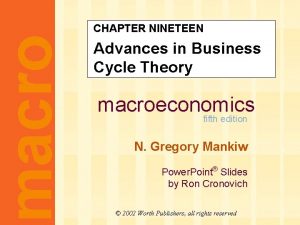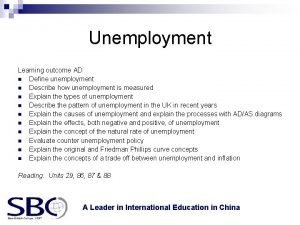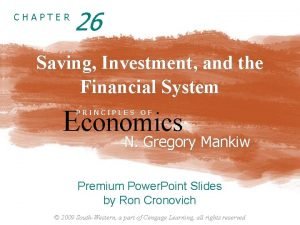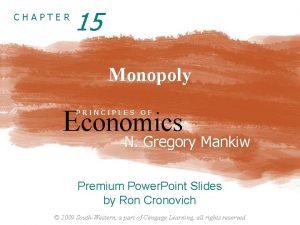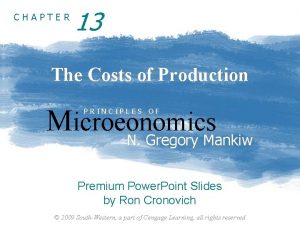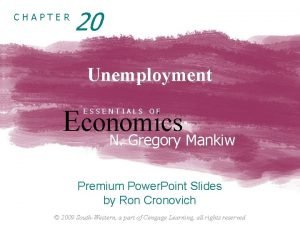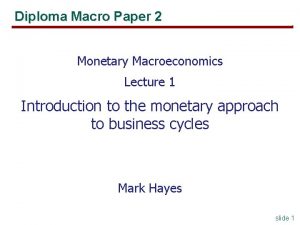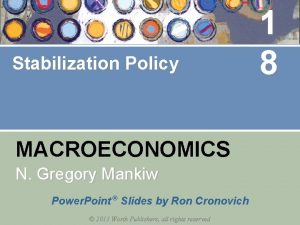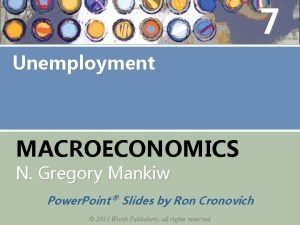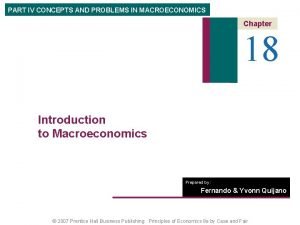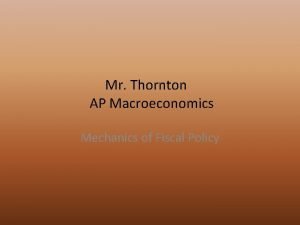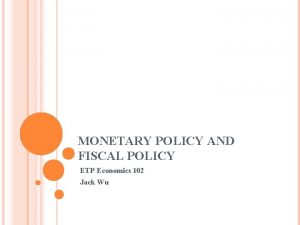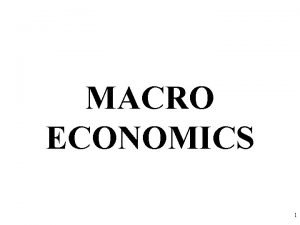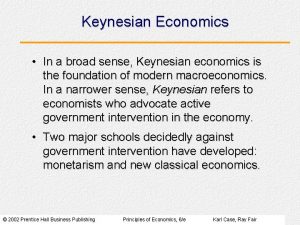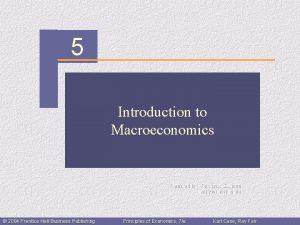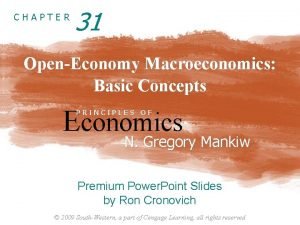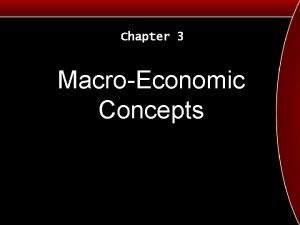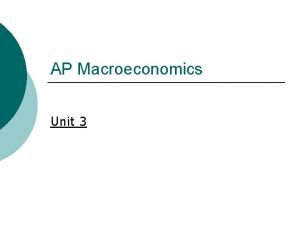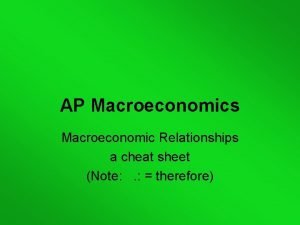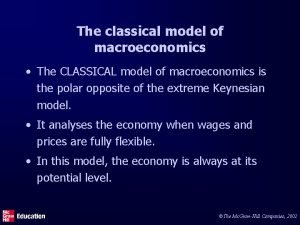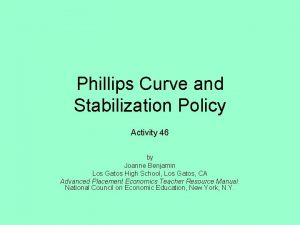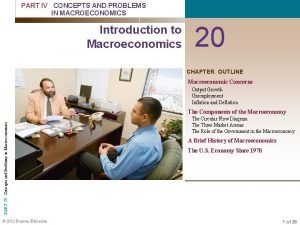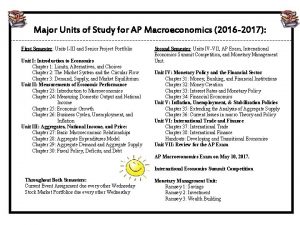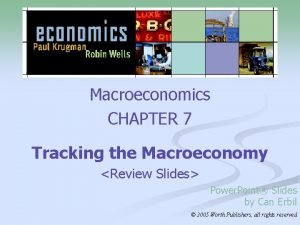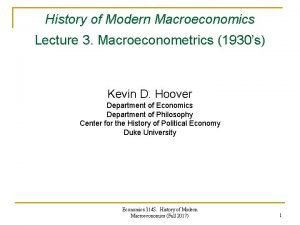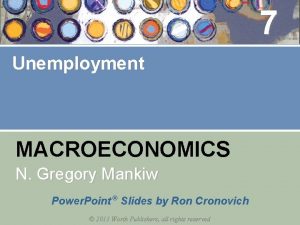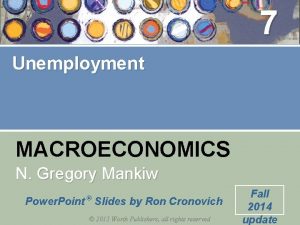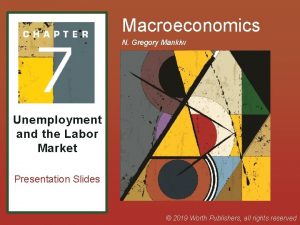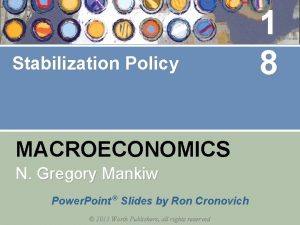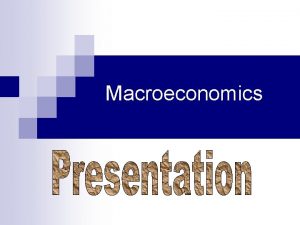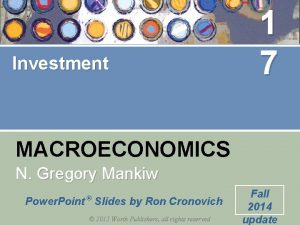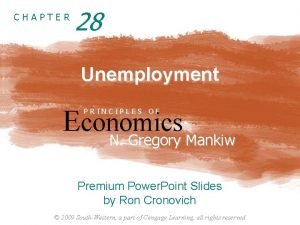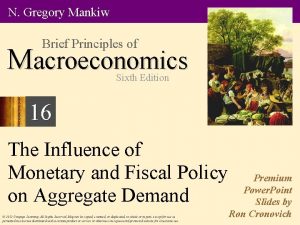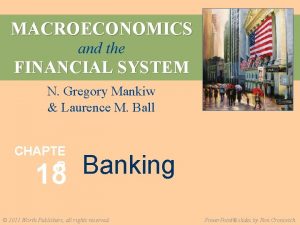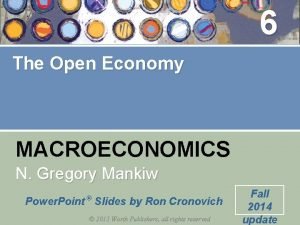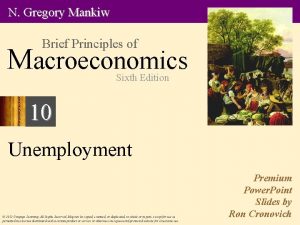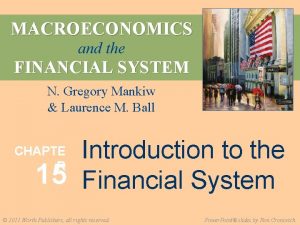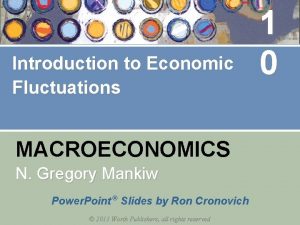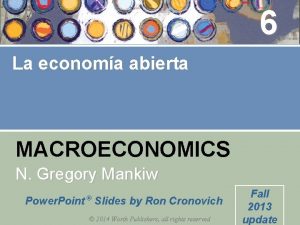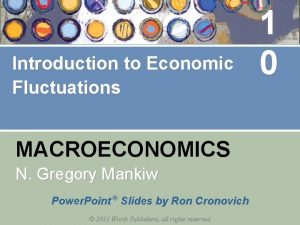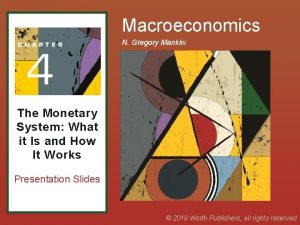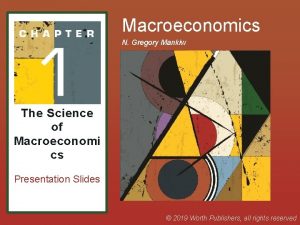7 Unemployment MACROECONOMICS N Gregory Mankiw Power Point











































- Slides: 43

7 Unemployment MACROECONOMICS N. Gregory Mankiw Power. Point ® Slides by Ron Cronovich © 2013 Worth Publishers, all rights reserved

IN THIS CHAPTER, YOU WILL LEARN: …about the natural rate of unemployment: § what it means § what causes it § understanding its behavior in the real world 1

Natural rate of unemployment § Natural rate of unemployment: The average rate of unemployment around which the economy fluctuates. § In a recession, the actual unemployment rate rises above the natural rate. § In a boom, the actual unemployment rate falls below the natural rate. CHAPTER 7 Unemployment 2

Actual and natural rates of unemployment, U. S. , 1960– 2012 12 Percent of labor force Unemployment rate 10 8 6 4 2 Natural rate of unemployment 0 1965 1970 1975 1980 1985 1990 1995 2000 2005 2010

A first model of the natural rate Notation: L = # of workers in labor force E = # of employed workers U = # of unemployed U/L = unemployment rate CHAPTER 7 Unemployment 4

Assumptions: 1. L is exogenously fixed. 2. During any given month, s = rate of job separations, fraction of employed workers that become separated from their jobs f = rate of job finding, fraction of unemployed workers that find jobs s and f are exogenous CHAPTER 7 Unemployment 5

The transitions between employment and unemployment s E Employed Unemployed f U CHAPTER 7 Unemployment 6

The steady state condition § Definition: the labor market is in steady state, or long-run equilibrium, if the unemployment rate is constant. § The steady-state condition is: s E = f U # of employed people who lose or leave their jobs CHAPTER 7 Unemployment # of unemployed people who find jobs 7

Finding the “equilibrium” U rate f U = s E = s (L – U ) = s L – s U Solve for U/L: (f + s) U = s L so, CHAPTER 7 Unemployment 8

Example: § Each month, § 1% of employed workers lose their jobs (s = 0. 01) § 19% of unemployed workers find jobs (f = 0. 19) § Find the natural rate of unemployment: CHAPTER 7 Unemployment 9

Policy implication § A policy will reduce the natural rate of unemployment only if it lowers s or increases f. CHAPTER 7 Unemployment 10

Why is there unemployment? § If job finding were instantaneous (f = 1), then all spells of unemployment would be brief, and the natural rate would be near zero. § There are two reasons why f < 1: 1. job search 2. wage rigidity CHAPTER 7 Unemployment 11

Job search & frictional unemployment § frictional unemployment: caused by the time it takes workers to search for a job § occurs even when wages are flexible and there are enough jobs to go around § occurs because § workers have different abilities, preferences § jobs have different skill requirements § geographic mobility of workers not instantaneous § flow of information about vacancies and job candidates is imperfect CHAPTER 7 Unemployment 12

Sectoral shifts § def: Changes in the composition of demand among industries or regions. § example: Technological change more jobs repairing computers, fewer jobs repairing typewriters § example: A new international trade agreement labor demand increases in export sectors, decreases in import-competing sectors § These scenarios result in frictional unemployment CHAPTER 7 Unemployment 13

CASE STUDY: U. S. Structural change over the long run CHAPTER 7 Unemployment 14

CASE STUDY: Korea Structural change over the long run < GDP Structure > Services 40% Agriculture, fisheries, and mining 45% 1963 Manufacturing 15% Agriculture, fisheries, and mining 2. 7% Manufacturing 39. 8% 2012 est. Services 57. 5% < Employment Structure > Source: Statistics Korea Note: The term "Primary" refers to the agricultural, forestry and fishery sectors; "Secondary, " the mining and manufacturing sectors; and "Tertiary, " social overhead capital (SOC) and other service sectors. CHAPTER 7 Unemployment 15 15

More examples of sectoral shifts § Industrial revolution (1800 s): agriculture declines, manufacturing soars § Energy crisis (1970 s): demand shifts from larger cars to smaller ones § Health care spending as % of GDP: 1960: 5. 2 1980: 9. 1 2000: 13. 8 2010: 17. 9 In our dynamic economy, smaller sectoral shifts occur frequently, contributing to frictional unemployment. CHAPTER 7 Unemployment 16

Public policy and job search Govt programs affecting unemployment include: § Govt employment agencies disseminate info about job openings to better match workers & jobs. § Public job training programs help workers displaced from declining industries get skills needed for jobs in growing industries. CHAPTER 7 Unemployment 17

Unemployment insurance (UI) § UI pays part of a worker’s former wages for a limited time after the worker loses his/her job. § UI increases search unemployment, because it reduces § the opportunity cost of being unemployed § the urgency of finding work §f § Studies: The longer a worker is eligible for UI, the longer the average spell of unemployment. CHAPTER 7 Unemployment 18

Benefits of UI § By allowing workers more time to search, UI may lead to better matches between jobs and workers, which would lead to greater productivity and higher incomes. CHAPTER 7 Unemployment 19

Why is there unemployment? The natural rate of unemployment: § Two reasons why f < 1: DONE 1. job search Next 2. wage rigidity CHAPTER 7 Unemployment 20

Unemployment from real wage rigidity If real wage is stuck above its eq’m level, there aren’t enough jobs to go around. Real wage Supply Unemployment Rigid real wage Demand Labor Amount of labor hired CHAPTER 7 Unemployment Amount of labor willing to work 21

Unemployment from real wage rigidity If real wage is stuck above its eq’m level, there aren’t enough jobs to go around. CHAPTER 7 Then, firms must ration the scarce jobs among workers. Structural unemployment: The unemployment resulting from real wage rigidity and job rationing. Unemployment 22

Reasons for wage rigidity 1. Minimum wage laws 2. Labor unions 3. Efficiency wages CHAPTER 7 Unemployment 23

1. The minimum wage § The min. wage may exceed the eq’m wage of unskilled workers, especially teenagers. § Studies: a 10% increase in min. wage reduces teen employment by 1– 3% § But, the min. wage cannot explain the majority of the natural rate of unemployment, as most workers’ wages are well above the min. wage. CHAPTER 7 Unemployment 24

2. Labor unions § Unions exercise monopoly power to secure higher wages for their members. § When the union wage exceeds the eq’m wage, unemployment results. § Insiders: Employed union workers whose interest is to keep wages high. § Outsiders: Unemployed non-union workers who prefer eq’m wages, so there would be enough jobs for them. CHAPTER 7 Unemployment 25

Union membership and wage ratios by industry, 2011 industry Private sector (total) # employed U % of total (1000 s) wage ratio 104, 737 6. 9 122. 6 20, 450 37. 0 121. 1 6, 244 14. 0 151. 7 780 7. 2 96. 4 Manufacturing 13, 599 10. 5 107. 2 Retail trade 14, 582 4. 9 102. 4 Transportation 4, 355 20. 4 123. 5 Finance, insurance 6, 111 1. 1 90. 2 12, 171 2. 1 99. 1 4, 020 13. 0 112. 6 15, 835 7. 5 114. 9 Government (total) Construction Mining Professional services Education Health care wage ratio = 100 (union wage) / (nonunion wage)

3. Efficiency wages § Theories in which higher wages increase worker productivity by: § attracting higher quality job applicants § increasing worker effort, reducing “shirking” § reducing turnover, which is costly to firms § improving health of workers (in developing countries) § Firms willingly pay above-equilibrium wages to raise productivity. § Result: structural unemployment. CHAPTER 7 Unemployment 27

NOW YOU TRY Question for Discussion § Use the material we’ve just covered to come up with a policy or policies to try to reduce the natural rate of unemployment. § Note whether your policy targets frictional or structural unemployment. 28

The Median Duration of Unemployment 25 The duration of unemployment typically rises in recessions—but its rise in 2008 – 2010 is unprecedented. 15 10 5 01/2007 01/2004 01/2001 01/1998 01/1995 01/1992 01/1989 01/1986 01/1983 01/1980 01/1977 01/1974 01/1971 01/1968 0 01/1965 Weeks 20

TREND: The natural rate rises over 1960– 84, then falls over 1985– 2005 Percent of labor force 8 7 6 5 4 1960 1965 1970 1975 1980 1985 1990 1995 2000 2005 2010

EXPLAINING THE TREND: The minimum wage $ 11 10 Dollars per hour 9 trend 8 7 6 The real minimum wage and natural u-rate have similar trends. minimum wage in 2012 dollars 5 4 3 2 minimum wage in current dollars 1 0 1955 1960 1965 1970 1975 1980 1985 1990 1995 2000 2005 2010

EXPLAINING THE TREND: Union membership selected years year percent of labor force 1930 12. 0 1945 35. 0 1954 35. 0 1970 27. 0 1983 20. 1 2011 11. 8 Since early 1980 s, the natural rate and union membership have both fallen. But, from 1950 s to about 1980, the natural rate rose while union membership fell.

EXPLAINING THE TREND: Sectoral shifts – 2011: less 1986– 2005: 2006 oil prices oil volatility increases – 1970– 1986: volatile oilprices volatile, so fewer sectoral shifts 120 willshifts the natural u-rate rise again? create jarring sectoral 140 100 80 60 Price per barrel of oil, in 2011 dollars 40 20 0 1965 1970 1975 1980 1985 1990 1995 2000 2005 2010

EXPLAINING THE TREND: Demographics § 1970 s: The Baby Boomers were young. Young workers change jobs more frequently (high value of s). § Late 1980 s through today: Baby Boomers aged. Middle-aged workers change jobs less often (low s). CHAPTER 7 Unemployment 34

Unemployment in Europe, 1960– 2011 12 Percent of labor force 10 8 6 4 France Germany Italy United Kingdom 2 0 1975 1980 1985 1990 1995 2000 2005 2010

Why unemployment rose in Europe but not the U. S. Shock Technological progress has shifted labor demand from unskilled to skilled workers in recent decades. Effect in United States An increase in the “skill premium” – the wage gap between skilled and unskilled workers. Effect in Europe Higher unemployment, due to generous govt benefits for unemployed workers and strong union presence. CHAPTER 7 Unemployment 36

Percent of workers covered by collective bargaining, selected countries United States 13% United Kingdom 35 Switzerland 48 Spain 80 Sweden 92 Germany 63 France 95 Greece 85

Percent of workers covered by collective bargaining, Korea CHAPTER 7 Unemployment 38

CHAPTER SUMMARY 1. The natural rate of unemployment § definition: the long-run average or “steady state” rate of unemployment § depends on the rates of job separation and job finding 2. Frictional unemployment § due to the time it takes to match workers with jobs § may be increased by unemployment insurance 39

CHAPTER SUMMARY 3. Structural unemployment § results from wage rigidity: the real wage remains above the equilibrium level § caused by: minimum wage, unions, efficiency wages 4. Duration of unemployment § most spells are short term § but most weeks of unemployment are attributable to a small number of long-term unemployed persons 40

CHAPTER SUMMARY 5. Behavior of the natural rate in the U. S. § rose from 1960 to early 1980 s, then fell § possible explanations: trends in real minimum wage, union membership, prevalence of sectoral shifts, and aging of the Baby Boomers 41

CHAPTER SUMMARY 6. European unemployment § has risen sharply since 1970 § probably due to generous unemployment benefits, strong union presence, and a technology -driven shift in demand away from unskilled workers 42
 Macroeconomics mankiw 9th edition
Macroeconomics mankiw 9th edition Macroeconomics by mankiw
Macroeconomics by mankiw Intermediate macroeconomics mankiw
Intermediate macroeconomics mankiw Unemployment graph macroeconomics
Unemployment graph macroeconomics Chapter 26 saving investment and the financial system
Chapter 26 saving investment and the financial system Chapter 15 monopoly
Chapter 15 monopoly Tc=fc+vc example
Tc=fc+vc example Mankiw slides
Mankiw slides Mankiw
Mankiw Principles of economics mankiw 9th edition ppt
Principles of economics mankiw 9th edition ppt Principles of economics mankiw 9th edition ppt
Principles of economics mankiw 9th edition ppt Real power formula
Real power formula Powerbi in powerpoint
Powerbi in powerpoint Point point power
Point point power Economics subject
Economics subject Components of macroeconomics
Components of macroeconomics Crowding out effect macroeconomics
Crowding out effect macroeconomics Crowding out effect macroeconomics
Crowding out effect macroeconomics Lesson 2 activity 45 macroeconomics
Lesson 2 activity 45 macroeconomics Responsbilties
Responsbilties What is the theory of liquidity preference
What is the theory of liquidity preference Microeconomics example
Microeconomics example What is macroeconomics
What is macroeconomics New classical macroeconomics
New classical macroeconomics New classical macroeconomics
New classical macroeconomics Crowding out
Crowding out 2012 macroeconomics frq
2012 macroeconomics frq Macroeconomics circular flow diagram
Macroeconomics circular flow diagram Ap macroeconomics-percentage for a 5
Ap macroeconomics-percentage for a 5 Chapter 31 open economy macroeconomics
Chapter 31 open economy macroeconomics Macroeconomics deals with
Macroeconomics deals with Monetarist vs classical economics
Monetarist vs classical economics New classical macroeconomics
New classical macroeconomics Ap macroeconomics unit 3
Ap macroeconomics unit 3 Macroeconomics cheat sheet
Macroeconomics cheat sheet Ap macro graphs
Ap macro graphs Macroeconomics
Macroeconomics Aw phillips curve
Aw phillips curve Macroeconomics components
Macroeconomics components Economics michael parkin 13th edition
Economics michael parkin 13th edition Macroeconomics review
Macroeconomics review Macroeconomics chapter 7
Macroeconomics chapter 7 Macroeconometrics
Macroeconometrics Growth rate of nominal gdp formula
Growth rate of nominal gdp formula

